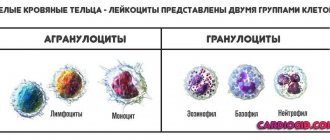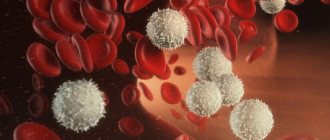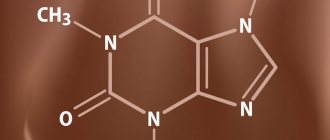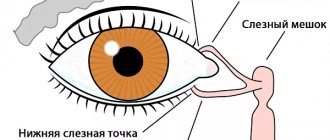Doctors call coughing up blood “hemoptysis.” This is the expectoration of blood or blood with mucus, which occurs when coughing. If there is blood in the mucus, this can be detected by the presence of characteristic streaks of blood, as well as the color of the mucus, which turns red or pink. Coughing up blood can occur in adults and older children and is rarely seen in young children.
When a person coughs up blood, the source of the blood is either the lungs or the upper respiratory tract. A nosebleed or stomach bleed may look similar to coughing up blood, but it is not the same thing.
If a person coughs up a large amount of blood, doctors call it “extensive hemoptysis.” This should be a signal for immediate hospitalization. This article will focus on hemoptysis, which does not require an emergency call to the ambulance.
Possible complications
Ignoring the symptoms of minor hemoptysis can lead to the development of massive bleeding.
It causes the airways to fill with blood, which blocks access to air. As a result, death from asphyxia (suffocation) may occur. Death is also possible with heavy blood loss, amounting to about 4–4.5% of the total body weight. If left untreated, the disease that caused hemoptysis continues to progress and cause complications. With cancer, metastases appear, with pneumonia and tuberculosis - fibrosis of the lung tissue, with bronchiectasis - bleeding, abscess, infarction and necrosis of the lung.
How to treat coughing up blood?
With moderate symptoms, and if this condition occurs during a cold, no special treatment is needed.
If treatment is necessary, the doctor will treat the condition that is causing the coughing up of blood. Your doctor can stop bleeding with the following treatment:
- Prescribe a cough medicine that eliminates cough;
- Prescribe antibiotics for bronchiectasis or lung infection;
- Carry out a special hemostatic procedure during bronchoscopy
- Treat PE if it is causing hemoptysis
What causes hemoptysis in cancer?
95% of the blood enters the lungs through the pulmonary arteries, which have low pressure. Having reached the capillary bed, it gives off carbon dioxide and is saturated with oxygen. The remaining part of the blood (5%) reaches the lungs through the bronchial arteries, which have high pressure. It nourishes the respiratory organs and respiratory tract. Hemoptysis is characterized by bleeding from the bronchial arteries. The only exceptions are cases when the pulmonary arteries receive mechanical damage.
Hemoptysis in lung cancer develops against the background of malignant transformation of the epithelium of the respiratory tract. Blood loss is usually minimal. Massive bleeding develops only when the tumor grows into a large artery. This is a dangerous condition that can lead to death due to asphyxia or excessive blood loss.
What causes coughing up blood?
- Adults may have many reasons for coughing up blood, but the most common are:
- Bronchitis. Bronchitis is inflammation of the bronchi. Bronchi are tubes that deliver air to the lungs. There are 2 types of bronchitis. Acute bronchitis is a consequence of a respiratory infection. Chronic bronchitis occurs as a result of a long-term inflammatory process in the bronchi - smoking, industrial production.
- Pneumonia is an infection of the lung tissue.
- Pulmonary tuberculosis
- Bronchiectasis, bronchiectasis, is a disease or condition in which the bronchial tree is severely deformed and therefore very easily infected. The reasons for its occurrence may be different.
- Lung cancer affects the bronchi or lung tissue
- PE pulmonary embolism
- Primary pulmonary hypertension
- In children, the main causes of coughing up blood may be the following:
- Infection of the bronchi, upper respiratory tract or lungs.
- Entry of objects or pieces of food into the respiratory tract. The object may remain in the airway for days or even weeks before coughing up blood begins.
- Bronchiectasis. In children, it appears as a result of cystic fibrosis, which can also be congenital. In cystic fibrosis, thick mucus accumulates in the lungs, leading to frequent infections.
Diagnostic methods in Medscan
Diagnosis for hemoptysis includes:
- Taking anamnesis - it is important to establish the history of the symptom and the presence of chronic diseases that could cause it.
- Physical examination - allows you to detect accompanying symptoms.
- Laboratory tests - Abnormalities in blood and urine values may be clinically significant.
- Computed tomography - in Medscan CT allows you to identify inflammatory processes, pulmonary neoplasms, determine their nature, stage of development and the presence of metastases.
- Bronchoscopy - this method makes it possible to assess the condition of the bronchi and take a sample of lung tissue for histological examination. Based on it, the doctor judges the presence of a tumor, its benignity or malignancy.
Are tests needed?
– Our pulmonologist or internist will ask you about your symptoms and order a test. Based on symptoms and taking into account other factors, tests may be prescribed. The test results will help your doctor identify the cause of bleeding.
- The following studies and tests may be prescribed:
- X-ray examinations, including chest CT
- Laboratory tests: blood test or sputum test
- Bronchoscopy. In this procedure, a bronchologist examines the airways using a bronchoscope.
- Angiopulmonography
Is there anything I can do myself to stop coughing up blood?
- Yes.
- Teenagers, as well as adults who find streaks of blood in their mucus, can use cough medications that are sold in pharmacies.
- But, DO NOT give cough or cold medicine to small children if they are coughing up blood. In these situations, medications are unlikely to help and may have side effects.
- If you smoke, the most effective way is to quit smoking.
- If you are taking anti-clotting drugs (drugs that thin the blood or prevent clotting), tell your doctor. The dosage may need to be changed.
Treatment methods in Medscan
The choice of treatment methods depends on the disease that caused hemoptysis and the stage of its development. For malignant neoplasms in the lungs, the following are prescribed:
- early resection;
- chemotherapy;
- radiation therapy;
- immunotherapy;
- targeted therapy;
- stereotactic radiotherapy.
In case of massive bleeding, Medscan specialists perform embolization of the bronchial artery. This is a minimally invasive method that involves blocking a bleeding vessel. It allows you to stop blood loss in 90% of cases. If there is no effect, emergency surgery is performed.
4.Treatment
Therapy in any case will be etiopathogenetic in nature (as far as possible), i.e. The main target will not be the cough itself, but the factors that cause it. The range of therapeutic approaches in modern pulmonology (and medicine in general) is extremely wide; their specific choice is determined by the diagnostic results. In some cases, standard anti-inflammatory treatment is sufficient, in others there are absolute indications for emergency surgery, etc.
It is important to emphasize once again: a doctor’s consultation is needed urgently or urgently if:
- “bloody” sputum expectorated with a cough is very copious and/or has a strong unpleasant odor;
- cough mixed with blood occurs against the background of “unreasonable” recent loss of body weight, hyperhidrosis (excessive sweating), fatigue;
- cough is accompanied by signs of pulmonary hemorrhage (profuse, frothy scarlet blood).
Prevention
The main methods of preventing hemoptysis are preventing the pathologies that cause it. Quitting smoking, maintaining a healthy lifestyle, regular exercise, and timely treatment of colds are important.
Sources:
- Earwood JS, Thompson TD. Hemoptysis: evaluation and management // Am Fam Physician. 2015 Feb 15;91(4):243-9.
- Ittrich H, Bockhorn M, Klose H, Simon M. The Diagnosis and Treatment of Hemoptysis // The Diagnosis and Treatment of Hemoptysis.Dtsch Arztebl Int. 2021 Jun 5;114(21):371-381. doi: 10.3238/arztebl.2017.0371.
- K. Krenev, I am Kabysh, O Yudin. Difficult patient or patient with hemoptysis // Sciences of Europe, 2021, No. 48, pp. 17-22
Treatment
Help before diagnosis
When purulent green sputum appears, it is very important to ensure that the respiratory tract is cleared of accumulated secretions. Patients are recommended to be in a postural drainage position several times a day and do breathing exercises. You should not take antitussive drugs that aggravate the course of the disease. Green sputum occurs with serious infectious or chronic processes, so self-medication is unacceptable.
Conservative therapy
Mild forms of chronic pathology are treated on an outpatient basis. Diseases that cause green sputum often dramatically worsen the patient's condition, requiring hospitalization. If signs of respiratory failure occur, oxygen support is provided. Etiopathogenetic therapy includes the following groups of drugs:
- Antibiotics
. Prescribed to destroy pathogenic microorganisms that cause the formation of purulent green sputum. Antimicrobial agents are selected taking into account the results of bacterial culture. For the treatment of tuberculosis, special antibiotics are used in combinations of 3-4 items. - Mucolytics
. They dilute sputum, due to which it is easily removed when coughing and does not stagnate in the bronchial tree. To enhance the effect, secretomotor agents are added that stimulate mucociliary clearance. - Bronchodilators
. Effective for chronic diseases accompanied by difficulty breathing. The drugs expand the lumen of the bronchi, so it becomes easier for a person to breathe, and phlegm is released freely during a coughing attack.
If standard measures are ineffective, they resort to bronchoalveolar lavage and aspiration of purulent secretions. When performing therapeutic bronchoscopy, intrabronchial administration of antibacterial drugs is possible. Among the physiotherapeutic methods, vibration chest massage, medicinal electrophoresis, and inhalations are actively recommended.
Causes of sputum
Mucus in the throat
- a natural reaction of our body to the appearance of an irritant. In this way, the body protects itself from infection: sputum increases in volume, and a person involuntarily coughs to free himself from viruses and harmful bacteria. After recovery, the amount of mucus returns to its normal, imperceptible level. If the feeling of phlegm in the throat has become constant, this may indicate a chronic ENT disease, or problems in the digestive and other systems of the body.
The causes of excess mucus can be different:
- cold;
- bronchitis;
- bronchial asthma;
- pneumonia (pneumonia);
- tuberculosis;
- sinusitis;
- chronic rhinitis;
- lung cancer.
In addition to the listed pathologies, smoking can also be a cause of sputum separation. In smokers, the mucous membrane of the respiratory tract is constantly exposed to the toxic effects of nicotine and cigarette tar. Chronic inflammation gradually provokes the production of sputum in quantities that force a person to cough every morning.
Main causes of hemoptysis
Hemoptysis is caused by diseases and neoplasms of the respiratory system, cardiovascular pathologies, gastrointestinal problems, foreign bodies in the respiratory system, and trauma.
Lung diseases lead to hemoptysis if tissue begins to disintegrate and blood vessels are damaged. The reason may be:
- pneumonia – inflammation of the lung tissue;
- bronchiectasis - dilation of the bronchi as a result of a purulent-inflammatory process;
- bronchitis – inflammation of the bronchial mucosa;
- vasculitis, which destroys the walls of blood vessels;
- tuberculosis;
- gangrene;
- bronchial fistulas;
- fungi and parasites;
- congenital malformations;
- chronic obstructive pulmonary disease.
A severe, prolonged cough due to respiratory tract infections can lead to rupture of small blood vessels in the laryngeal mucosa. In such cases there is little blood, it is released in patches. A small amount of bloody discharge is possible with sinusitis and frontal sinusitis.
Tuberculosis is accompanied by mucopurulent sputum with bloody inclusions of a bright red hue, alternating with the discharge of pure blood.
The type of sputum in pneumonia depends on the type:
- In case of croup - a sparse brown or brownish tint.
- With hemorrhagic it is bright red.
- During acute pneumonia, there may be a cough of pure blood or with impurities.
In case of malignant tumors in the lungs, raspberry sputum is coughed up. Hemoptysis is caused by bronchial adenoma, hemangioma, and other neoplasms.
Hemoptysis can be an alarming sign of diseases of the cardiovascular system . With mitral stenosis, blood with scarlet streaks. In the case of atherosclerotic cardiosclerosis, hypertension, myocardial infarction, at the beginning of a cough, scarlet sputum is released, turning into a more saturated bloody one.
Blood comes out with a cough when there is a stomach or duodenal ulcer. In women, hemoptysis may be a consequence of endometriosis - the proliferation of endometrial cells in the respiratory organs.
Diagnosis of causes
To establish the exact source of expectoration of blood in the morning, instrumental and laboratory studies are necessary. An approximate list of diagnostic procedures:
- general blood analysis;
- coagulogram (blood test for clotting);
- general sputum analysis;
- culture of sputum for microflora;
- X-ray (fluorography) of the chest;
- CT, MRI of the chest;
- Mantoux test;
- echocardiography if a cardiac cause of hemoptysis is suspected;
- bronchoscopy;
- biopsy.
https://youtu.be/bjxkNsPKTxE
It should be remembered that the last two methods can cause additional trauma and increased hemoptysis. The listed methods allow you to timely diagnose and successfully treat the cause of coughing up blood in the morning. The main thing is not to delay seeing a doctor.
3. Symptoms and diagnosis
Pulmonary hemorrhage may appear suddenly or develop gradually from hemoptysis, but in any case it is accompanied by sallow pallor, cold hyperhidrosis, cyanotic discoloration of the skin of the extremities, a sharp decrease in blood pressure, tachycardia, tinnitus, dizziness, weakness, often anxious-panic disorganization of the psyche, disorders vision, convulsions, confusion with transition to deep fainting, stuporous state or agony.
Death usually occurs due to asphyxia and/or hypovolemic shock caused by rapid massive blood loss.
There is usually very little time left for diagnosis and taking emergency life-saving measures, and in such cases, much depends on the doctor’s ability to pay attention to the color of the blood, the nature of pulmonary wheezing, breathing patterns, heart murmurs, etc. An urgent consultation with a specialized specialist (gastroenterologist, parasitologist, oncologist, etc.) or instrumental examination (FEGDS, MRI, CT, radiography, bronchoscopy) is often necessary. Samples of biomaterial (sputum, blood, pus, etc.) are sent for laboratory biochemical, histological, microbiological analysis.
About our clinic Chistye Prudy metro station Medintercom page!
When to Seek Help Immediately
Dial 103, 112 or go to the nearest emergency department if Coughing up blood: MedlinePlus Medical Encyclopedia:
- coughing up blood began after a fall or chest injury;
- there is a lot of blood when coughing - 2 or more teaspoons;
- in addition to sputum, blood appeared in the stool or urine;
- hemoptysis Coughing up blood Causes - Mayo Clinic (this is the name for the process of releasing blood with sputum) is accompanied by other symptoms - chest pain, severe dizziness, fever, shortness of breath.
Such signs indicate serious disorders in the upper respiratory tract, lungs or cardiovascular system. If you don't seek help immediately, you could die.
Fortunately, hemoptysis does not always signal dangerous conditions.
Currently reading











